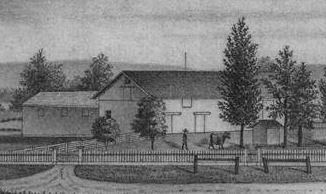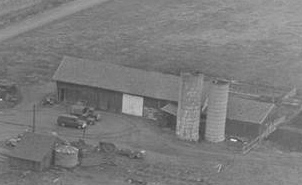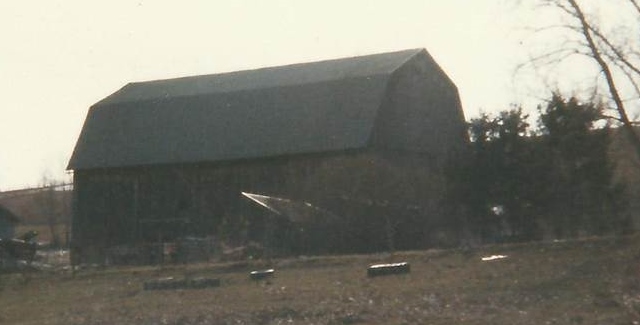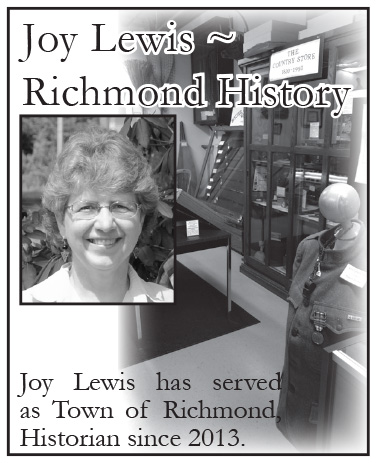Barns! Barns! Barns!
Richmond History
- JOY LEWIS –
Tarzan was not as tough as he claimed to be. With a flying tackle to the knees I brought him down, sat on his chest, and pinned him to the ground. Score one for the Girls. Tarzan, Captain of the Boys, was my cousin Tom. On his side were his brothers Steve and Bruce and my brother Rob. The Girls were myself, my sister Wendy, and our cousin Bonnie. Each team had its own crenelated fort of hay bales in the barn loft. In and out of the haymow we chased one another, up and down the ladder and through the stalls on the ground floor of the barn and into the yard. Prisoners were taken and points were scored. I have such memories of playing in a barn!
I did not grow up on a farm, but I was blessed with an abundance of cousins and friends who did. Most of my experiences in a barn or farmyard were as a playground. At Aunt Gene’s we raced one another across the cavernous barn floor and climbed to the top of the silo just to peek inside. At Uncle Frank’s we constructed elaborate fortifications of hay bales and drank out of rain barrels. At Uncle Charlie’s we petted the horses and helped with the harnessing gear, then clambered aboard a straw-covered wagon for a ride around the block. At the Kozas’ we swung from a rope tied high in the barn rafters and tiptoed across narrow beams, practicing walking a tightrope. Of all the barns I knew as a youngster, it was only in Uncle George’s barns that I ever did a lick of work.



Photo courtesy of Joy Lewis
George Bancroft (1926-2015) bought a farm in Ossian in the 1950s. Before that, in the early years of his married life, he worked as hired man for his uncle, Dick Farrell (my grandmother’s brother), on his Richmond farm. The farm on the southeast corner of Shetler and O’Neil Roads is still owned by Dick’s family. Dick’s father Jud Farrell bought the farm on the opposite corner in 1935; Jud’s son Charlie later owned that farm and now Charlie’s granddaughter lives there.
Some years later Uncle George had his own farm in Ossian where he specialized in raising sheep: Dorset, Suffolk, and Columbia. For many years his was the largest sheep farm in New York State. He also had cows and pigs and chickens and horses – and a spotted pony named Popcorn. There were seemingly endless acres of corn and alfalfa and open meadow.
In the cow barn my cousin Nancy showed me how to coax a reluctant Holstein into a stanchion then to quickly snap shut the gate. We washed a dozen udders and attached the milking machine. Cleaning out the gutters after the cows were released outside was not my favorite job. Bottle feeding the orphaned lambs was more to my liking. On hot June Saturdays Wendy, Rob, and I worked with our cousins to store hay bales in the mow; my siblings and I thought it was a lark. Nancy, Charles, and Phyllis knew it was work!
There is always work to do on a farm. Childhood memories of playing in a barn ought not to obscure that truth. Barns, first and foremost, are workstations on a farm. More than two hundred years ago, when most of Richmond’s families were farmers, the barns they erected were made of hewn logs. One of the first log barns in Richmond of which we have a record is that of Gideon Walker, who came to town in 1804.
Within a decade of the early settlers’ arrival were the first sawmills established. Sawn lumber, now readily available, facilitated construction. Much of this region was peopled by incomers from New England, where the English barn predominated. This was a building of three bays, thirty to forty feet long, with gable ends, an outer skin of narrow vertical boards, and a roof topped with hand-riven wood shingles. The central bay consisted of a threshing floor with wide hinged doors, front and back, opening outward. The bays either side of the threshing floor served as feed storage or to shelter livestock during the winter. The English barn was a constant in Richmond for more than half a century.
After the Civil War a new type of barn began it appear on the farms of Richmond – the gambrel-roofed structure which many consider the epitome of barn-ness. Its spacious interior accommodated a large mow under the rafters for hay storage, while the lower floor lodged a variety of livestock. The angle at the peak of the roof was called a “gambrel” as it resembled the gambrel bar used in the butchering of hogs. Many an English-style barn was remodeled in the 1870s to retrofit a gambrel roof. And in the decades following, new barns were apt to follow the iconic form. In the first two decades of the twentieth century George Wood of Richmond built fifteen plank-frame gambrel barns throughout Richmond, Bristol, Naples, and Canadice. One still standing is the Pierpont barn on the northwest corner of Abbey and Pierpont Roads.
My appreciation of barns is fueled as much by memory as by family lore: learning which barns in Rush, Henrietta, and Livonia were built by my ancestors; sharing the loss when Uncle Dick’s barn burned; knowing the local barns where my parents and grandparents worked on a daily basis. In the late 1930s my maternal grandfather, George H. Bancroft, operated a farm on Poplar Hill Road in Lima. A few years ago, I noticed the barn had collapsed. With permission of the landowner my husband scavenged several timbers from the old barn and made them into picture frames for me and my mother, allowing the life of that barn to continue holding and sharing memories.

One thought on “Barns! Barns! Barns!”
Comments are closed.
Great article. Thanks for posting it.